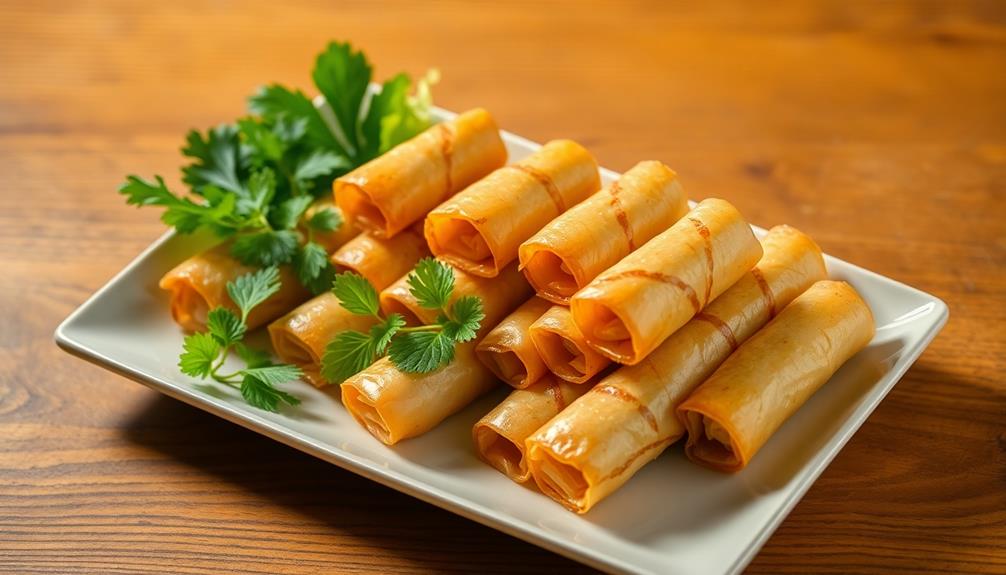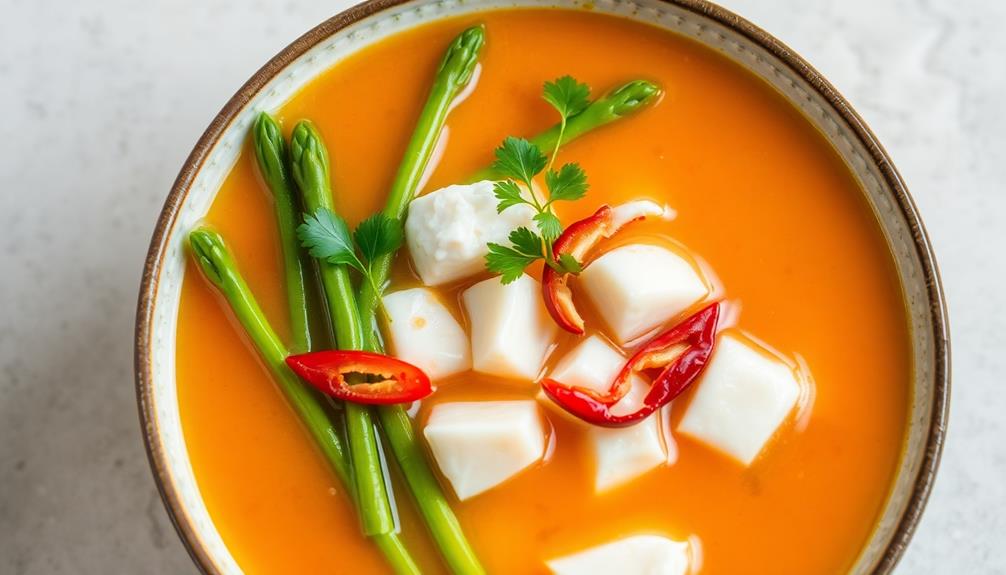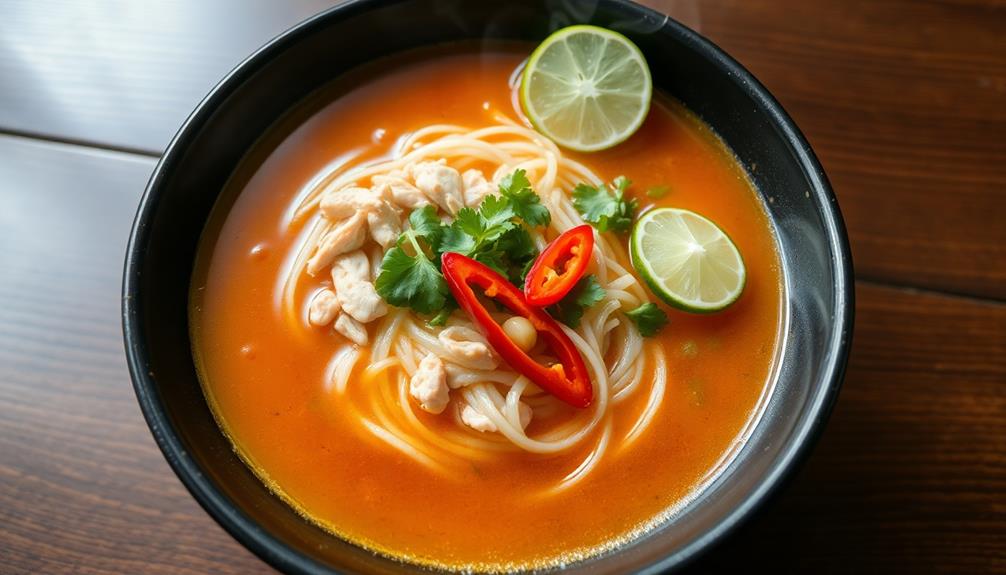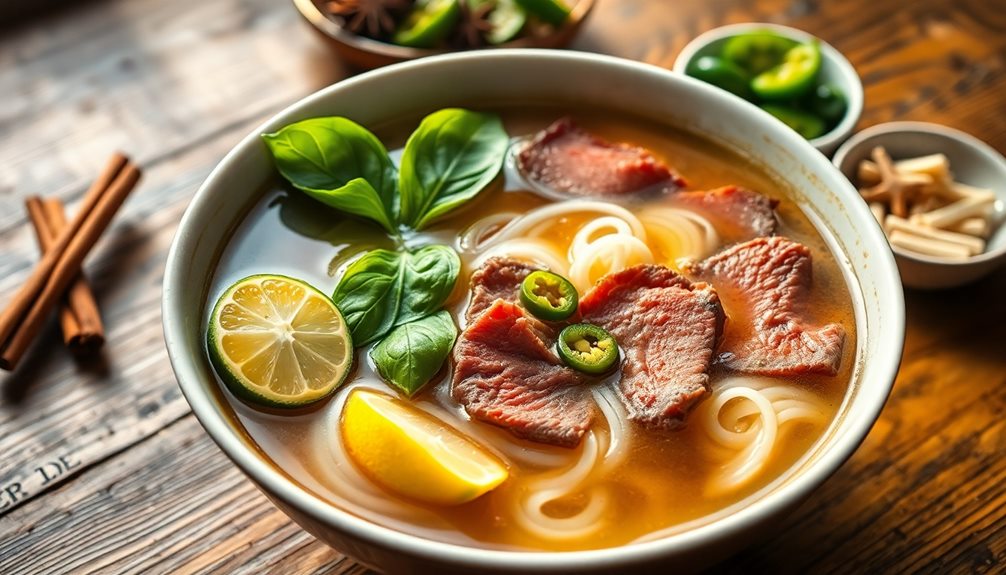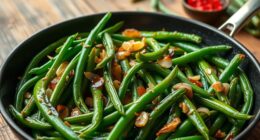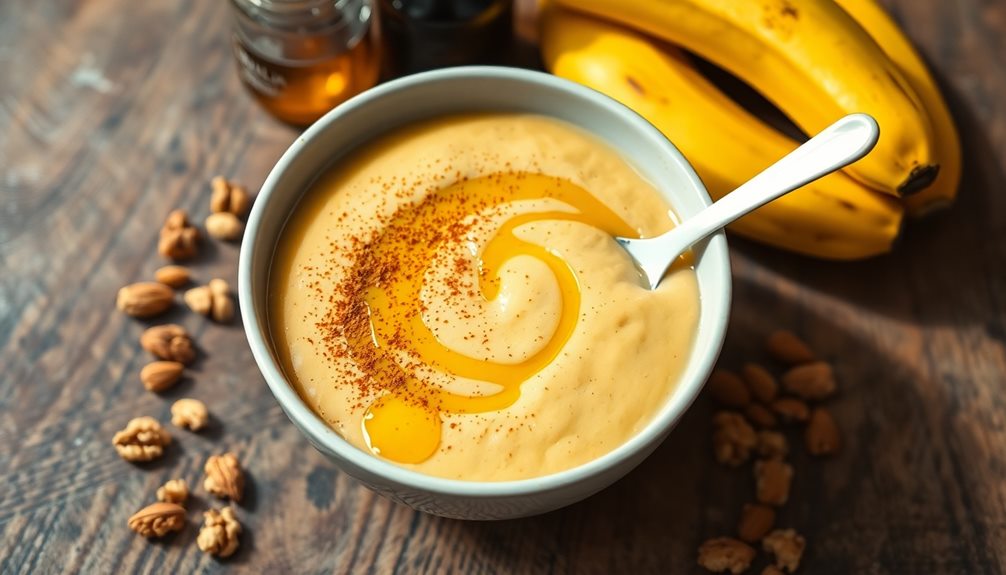You'll love the crispy and flavorful fried spring rolls, known as Nem Ran or Cha Gio, that are a beloved Vietnamese street food! These tasty rolls feature a golden-brown exterior that gives way to a savory, veggie-packed filling – it's a mouthwatering contrast of textures and flavors that'll have you coming back for more. Traditionally served as an appetizer or snack, these spring rolls represent the vibrant culinary heritage of Vietnam. Dip them in a tangy sauce for an extra punch of flavor, and enjoy the aroma and anticipation before taking that first delightful bite. There's so much more to learn about this beloved Vietnamese dish!
Key Takeaways
- Nem Ran/Cha Gio is a traditional Vietnamese fried spring roll dish, known for its crispy wrappers and flavorful fillings.
- The dish originated in ancient China as a celebration of spring and has since spread and adapted to local cuisines.
- Key ingredients include fresh vegetables, seasoned meat, and rice paper or wheat flour wrappers, which are deep-fried until golden brown.
- Proper preparation involves soaking the wrappers, assembling the filling, and rolling the rolls tightly before frying for optimal crispiness.
- Nem Ran/Cha Gio is often served with a tangy dipping sauce and is a popular street food and appetizer in Vietnam, reflecting its cultural heritage.
History
Spring rolls have a rich history that spans centuries and cultures. These delightful fried treats originated in ancient China, where they were first enjoyed as a way to celebrate the arrival of spring. Over time, the recipe spread to neighboring countries, each putting their own unique spin on the classic dish.
In Vietnam, for example, fried spring rolls are known as "Nem Ran" or "Cha Gio." These savory parcels are stuffed with a variety of ingredients, including shredded pork, carrots, and glass noodles, all wrapped in a crispy, golden-brown shell. Traditionally, Nem Ran is served as an appetizer or as part of a larger meal alongside fresh herbs and lettuce for wrapping. For those looking to try their hand at making this delicious dish at home, a nem chua recipe can be easily found online with step-by-step instructions on how to prepare and fry the spring rolls to perfection. Additionally, these savory parcels are a staple in Vietnamese cuisine and are enjoyed by people all over the world for their crispy texture and flavorful filling.
The flavors are a harmonious blend of salty, sweet, and tangy, making them irresistible to both young and old.
As you bite into a freshly fried spring roll, you'll be transported to faraway lands and ancient traditions. These delectable snacks are a testament to the rich culinary heritage of Asia, and they continue to delight and inspire people around the world.
Recipe
Fried spring rolls are a classic appetizer that can be enjoyed year-round. The combination of crispy fried wrappers and a savory, flavorful filling makes them a crowd-pleasing favorite. Whether you're hosting a party or looking for a tasty snack, this recipe will guide you through the process of creating delicious homemade fried spring rolls.
The key to successful fried spring rolls lies in the balance of the filling ingredients. The filling should be a mixture of fresh vegetables, proteins, and seasonings that complement each other perfectly. For inspiration on how to enhance the flavors and textures of your filling, consider adding elements similar to those found in a bread pudding which often incorporates various spices and fruits.
By carefully selecting and combining these components, you can achieve a filling that's both flavorful and satisfying.
- Spring roll wrappers
- Ground pork or chicken
- Shredded cabbage
- Shredded carrots
- Diced onions
- Minced garlic
- Soy sauce
- Rice vinegar
- Sesame oil
- Salt and pepper
To prepare the fried spring rolls, first, make the filling by sautéing the ground meat, vegetables, and seasonings until cooked through and fragrant. Allow the filling to cool slightly, then roll it up tightly in the spring roll wrappers.
Fry the rolls in hot oil until golden brown and crispy. Serve the fried spring rolls hot, accompanied by your favorite dipping sauce, such as sweet chili or soy sauce.
Cooking Steps
Soak the rice paper sheets in warm water until they're nice and soft.
Drain off any excess water, then get ready to assemble your tasty filling.
Fold the rice paper over the filling and gently press to seal, then fry the rolls in hot oil until they're golden brown and crispy.
Step 1. Soak Rice Paper in Warm Water

To begin the assembly process, you'll want to soak the rice paper wrappers in warm water for a minute or two until they become pliable and easy to work with.
As the rice paper softens, it'll transform from a stiff, brittle sheet into a supple, translucent wrap that's perfect for rolling up your delicious filling.
Be careful not to leave the wrappers in the water for too long, or they'll become overly soft and tear easily.
Once they're just right, gently remove them one by one, letting any excess water drip off before laying them flat on a clean, dry surface.
This simple step sets the stage for you to assemble your spring rolls with ease.
With the rice paper prepped and ready, you can start building your tasty creations, layer by flavorful layer.
Get ready to roll up some springtime goodness!
Step 2. Drain Excess Water From Sheets
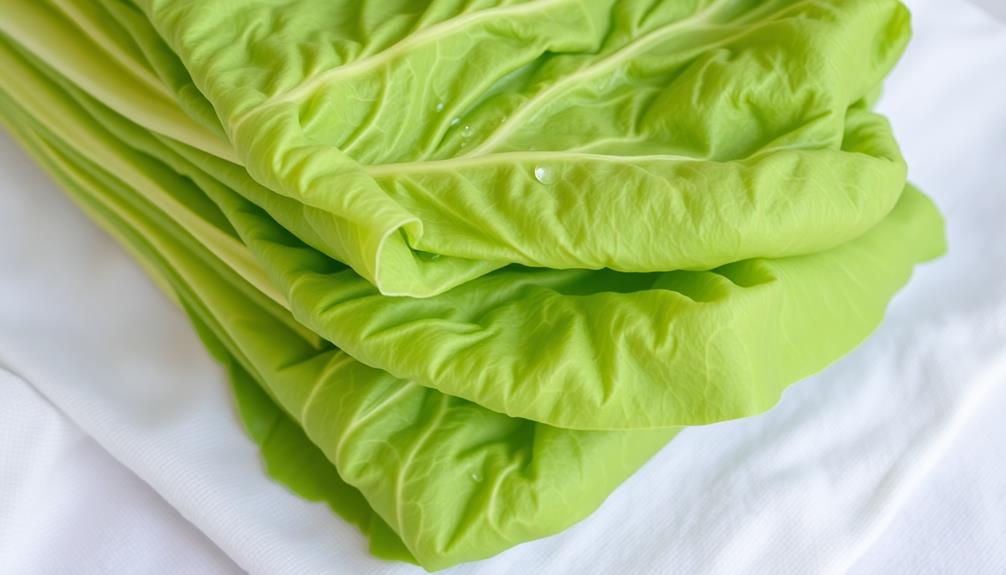
After soaking the rice paper wrappers, you'll want to remove any excess water before assembling your spring rolls.
Gently lay the softened sheets on a clean, dry surface. Using your hands, lightly pat the wrappers to soak up any extra moisture. You don't want them dripping wet – just damp enough to be pliable.
Next, carefully peel the sheets off the surface, one by one. As you lift each one, allow any remaining water to drip off. You can also gently shake or wave the wrapper back and forth to help the water slide right off.
This step is important so your spring rolls don't get soggy when fried.
With your nicely drained wrappers, you're all set to start filling and rolling up your tasty spring rolls! The filling ingredients will stick beautifully to the slightly damp, pliable sheets.
Get ready for some crispy, golden brown perfection.
Step 3. Assemble Filling in Rice Paper
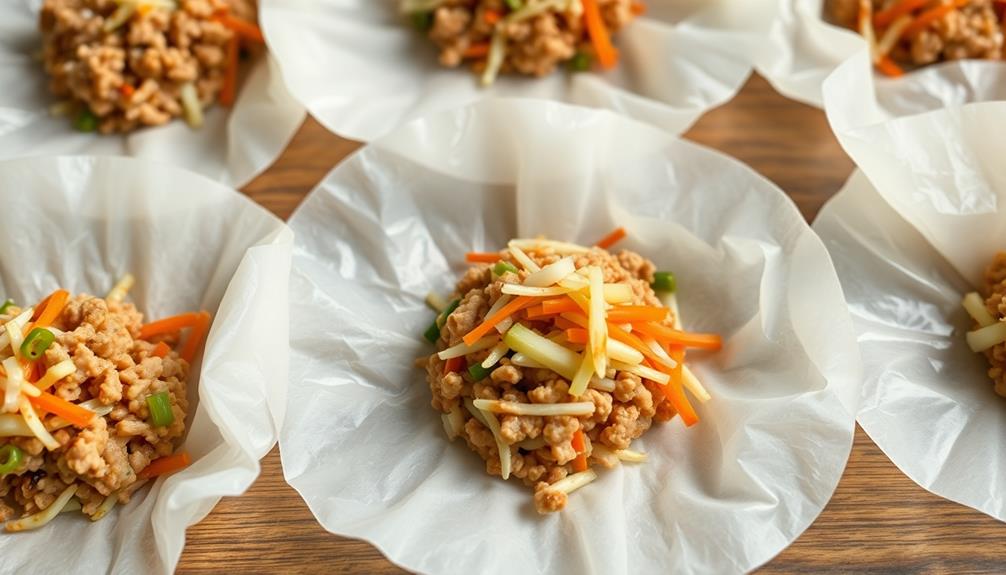
With your nicely drained wrappers, lay one sheet flat on a clean, dry work surface.
Place a heaping tablespoon of the cabbage and carrot filling in the center. For an extra kick of flavor, you might consider adding some fresh herbs, like cilantro or mint, to the filling, as they complement the savory aspect beautifully.
Fold the bottom edge up over the filling, then fold in the sides and continue rolling tightly to the top. Wet your fingertips and run them along the edge to seal the roll.
Repeat this process until you've used up all the filling.
Now, it's time to fry your spring rolls! Heat about an inch of oil in a large skillet over medium-high heat.
When the oil is shimmering, gently add the rolls, being careful not to overcrowd the pan. Fry for 2-3 minutes per side, until golden brown and crispy.
Drain the fried rolls on a paper towel-lined plate.
Once cooled slightly, your delicious homemade spring rolls are ready to enjoy! Serve them warm with your favorite dipping sauce.
The flaky wrappers and savory filling make every bite absolutely irresistible, reminiscent of the delightful flavors found in crab cakes.
Step 4. Fold Rice Paper Over Filling

Take the neatly drained wrappers and lay one flat on a clean, dry work surface.
Grab the bottom third of the wrapper and fold it up, then fold in the sides. Next, tightly roll the wrapper up from the bottom, tucking the filling as you go. Roll it into a nice, tight cylinder.
Repeat this process with the remaining wrappers, being careful not to overstuff them.
You'll want to work relatively quickly, as the rice paper can dry out and become brittle if left sitting for too long.
When you're all done, you should have a lovely lineup of perfectly rolled spring rolls, just waiting to be fried up into crispy, golden perfection.
Now, let's get them sizzling!
Step 5. Fry Rolls Until Golden Brown

Heat a few inches of oil in a large, heavy-bottomed pot or Dutch oven over medium-high heat.
Once the oil is hot, gently lower the folded spring rolls into the bubbling oil. Fry them for 2-3 minutes, turning occasionally, until they're a beautiful golden brown all over.
Mmm, you can already smell that delicious aroma wafting through the air! Be careful – the oil will be very hot, so use tongs or a slotted spoon to flip the rolls.
As they cook, the rice paper will turn crispy and the filling will heat through. When they're done, use the tongs to transfer the fried spring rolls to a paper towel-lined plate to drain off any excess oil.
They'll be so crispy on the outside and warm and flavorful on the inside – your mouth is watering just thinking about it, isn't it?
Serve the fried spring rolls hot, with your favorite dipping sauce on the side.
Final Thoughts
After following the recipe carefully, you can now enjoy the crispy and flavorful fried spring rolls. The golden-brown exterior gives way to a delightful burst of flavors, with the savory filling complementing the crunchy texture perfectly.
The aroma of the fried spring rolls will have your mouth watering, and the first bite will transport you straight to the bustling streets of Vietnam.
These homemade spring rolls are a true delight, and you should feel proud of your culinary accomplishment. Share them with your family and friends, and watch their faces light up with joy as they savor each delicious morsel.
The combination of the fresh vegetables, seasoned meat, and the perfectly fried wrapper is simply irresistible. Dip them in the tangy dipping sauce, and let the flavors dance on your tongue.
Enjoy every moment of this authentic Vietnamese experience, and don't be surprised if you find yourself craving these fried spring rolls again and again.
Frequently Asked Questions
What Is the Difference Between Nem Ran and Cha Gio?
The difference between nem ran and cha gio is that nem ran refers to Vietnamese fried spring rolls, while cha gio is the term used in Vietnamese cuisine for the same dish. Both describe the same savory, crispy appetizer.
How Can I Make the Spring Rolls Less Greasy?
To make your spring rolls less greasy, you can try using a lighter oil for frying, like canola or vegetable oil, and ensuring the oil is hot enough before adding the rolls. You can also try baking them instead of frying.
Can I Use Frozen Spring Roll Wrappers?
You can use frozen spring roll wrappers, but you'll need to handle them carefully. Thaw them according to the package instructions, and be gentle when wrapping and rolling to prevent tearing. With proper prep, they can work well.
How Long Can I Store the Uncooked Spring Rolls?
You can store the uncooked spring rolls in the freezer for up to 3 months. Make sure to wrap them tightly in plastic or place them in a resealable bag to prevent freezer burn.
What Is the Best Dipping Sauce for Nem Ran/Cha Gio?
The best dipping sauce for your fried spring rolls is a combination of sweet, sour, and savory flavors. You can't go wrong with a simple fish sauce, lime juice, and chili sauce mixture.
